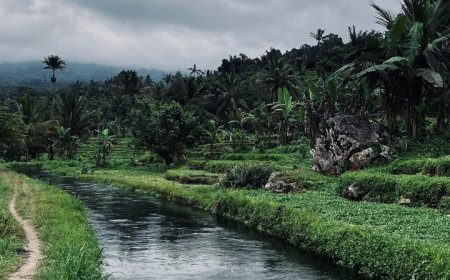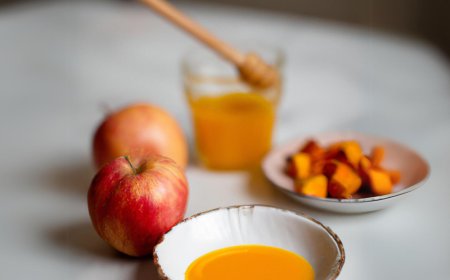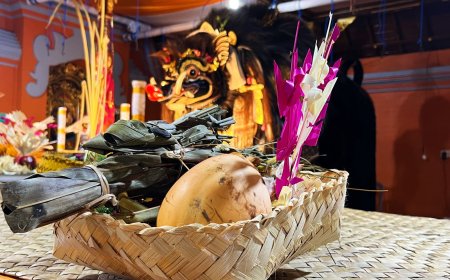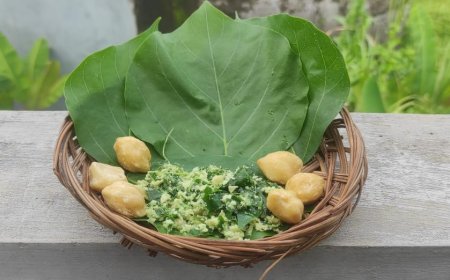Jangu, Aquatic Plant with a Distinctive Scent and Many Benefits
Jeringau (Acorus Calamus L), or known as Jangu in Balinese, is one of the herbal plants that thrive in wet environments such as marshes and ponds. This plant resembles grass but has thicker leaves and a very distinctive scent. However, did you know that this aquatic plant has many benefits? In the Lontar Usadha Tiwang, many treatments for various illnesses use this plant as one of its ingredients. For more details, let's explore the following article until the end.
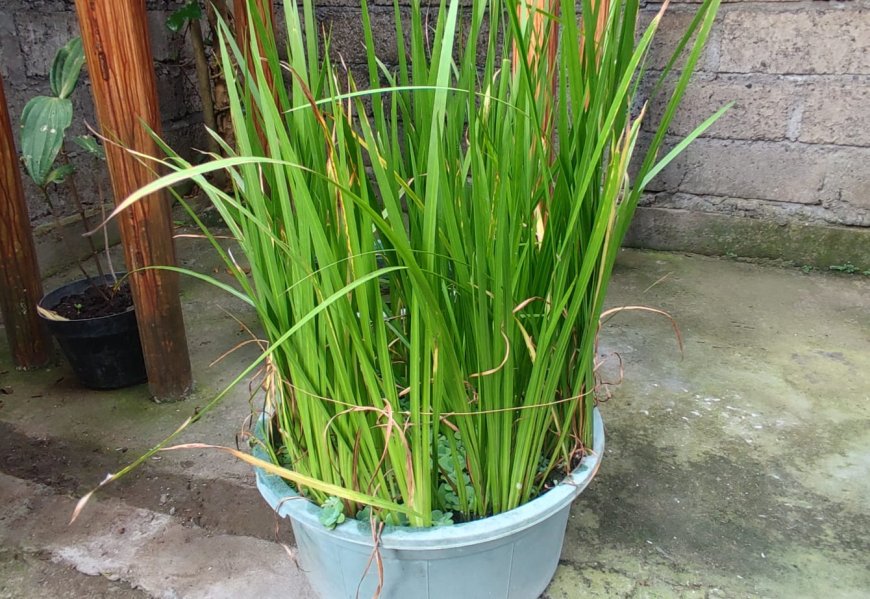
Traditional Balinese Herbal Medicine, commonly known as Usadha, is a form of treatment based on the use of herbal remedies and is believed to be rooted in concepts found in the Ayur Weda scriptures. Ayur Weda is a part of Weda Smrti that discusses the fundamental principles of medicine, patient examination techniques, disease diagnosis, the process of medicine preparation, and ethical aspects in medical practice.
Jangu or Jeringau (Acorus Calamus L) is one of the aquatic plants frequently mentioned in one of the Balinese Usadha manuscripts, known as Lontar Usadha Tiwang, which primarily deals with the treatment of Tiwang, a condition characterized by sensations of physical weakness, pain and discomfort, restlessness, rapid eye blinking, stiffening of muscles, and it can even lead to loss of consciousness. The type of Tiwang can be identified based on the symptoms it presents, such as the Northern Tiwang, characterized by restlessness (meunyang-anyingan) and rapid eye blinking, and the Tojos Tiwang, which includes restlessness (meunyang-anyingan), rapid eye blinking, and difficulty keeping the hands still (pati grèpè).
In the Lontar Usadha Tiwang, the Jangu plant is one of the key ingredients widely used in the treatment of various Tiwang diseases. These include Northern Tiwang, Asu Tiwang, Udel Tiwang, Mang Tiwang, Nanipi Tiwang, and others. In other words, Jangu plays a significant role in healing the various forms of Tiwang diseases described in the Lontar Usadha Tiwang. Here is further explanation about the treatment of these Tiwang diseases that have been mentioned.
- Northern Tiwang is one of the types of Tiwang diseases characterized by restlessness (Meuyang-anyingan) and blinking eyes. The lontar also mentions a mixture of medicinal ingredients required, including Gamongan (Zingiber zerumbet), Triketuka {Kesuna (Allium sativum L), Jangu (Acorus calamus), Mesui (Cryptocarya massoy (Oken) Kosterm.)}, and Tain seksek. The treatment method described here involves grinding all the medicinal ingredients and then applying them.
- Asu Tiwang is one of the types of Tiwang diseases with symptoms of excruciating pain. The lontar also lists a mixture of medicinal ingredients needed, including Kunir (Curcuma demostica), Tabia bungkut (Piper retrofractum, Piper longum L), Triketuka {Kesuna (Allium sativum L), Jangu (Acorus calamus), Mesui (Cryptocarya massoy (Oken) Kosterm.)}, and Daging kameri (Aleurites moluccanus (L.) Willd). The treatment method mentioned here involves grinding all the medicinal ingredients and then applying them.
- Udel Tiwang is one of the types of Tiwang diseases characterized by pain in the navel and abdominal stiffness (kenyat). The lontar also mentions a mixture of medicinal ingredients required, including burnt pangi bark (Pangium edule), Idubang, Triketuka {Kesuna (Allium sativum L), Jangu (Acorus calamus), Mesui (Cryptocarya massoy (Oken) Kosterm.), Lenge (Sesamum indicum L.). The treatment method described here involves grinding all the medicinal ingredients and then applying them to the navel.
- Mang Tiwang is one of the types of Tiwang diseases characterized by gaping mouth and stiffness. The lontar also mentions a mixture of medicinal ingredients required, including Daun tube jenu, Kayu nyali, Triketuka {Kesuna (Allium sativum L), Jangu (Acorus calamus), Mesui (Cryptocarya massoy (Oken) Kosterm.)}. The treatment method mentioned here involves grinding all the medicinal ingredients and using them as a powder.
- Tiwang Nanipi is one of the types of Tiwang diseases characterized by abdominal pain that feels crampy or stabbing. The lontar also mentions a mixture of medicinal ingredients required, including Babakan awar-awar (Ficus septica), Kasuna (Allium sativum), and Jangu (Acorus calamus). The treatment method described here involves scattering all the medicinal ingredients.
From a scientific perspective, this aquatic plant contains various compounds that are beneficial for health. These compounds include monoterpene, sesquiterpene, phenylpropanoid, flavonoid, quinine, alpha and beta-asarone compounds, lectin, phenol, saponin, tannin, and triterpenes. Medically, these compounds offer various health benefits, making this plant effective in treating various ailments such as flu, inflammation, fever, anemia, nervous disorders, asthma, anxiety (as a sedative), hormonal imbalances, aiding in metabolism, diabetes, stroke, abdominal pain, bloating, and healing skin wounds.
Jangu or Jeringau originally hails from India and has spread to Indonesia. Apart from its medicinal uses, this plant is also used as a culinary ingredient. In Bali, it has cultural significance and is employed in traditional ceremonies. For example, before Nyepi, during the pengerupukan ceremony, Jangu leaves are chewed with kesuna or garlic and then scattered around the yard. This is done to neutralize any negative energies present in the surroundings.
Cultivating this plant at home is relatively simple, provided you have a pot. To grow this plant, you'll need Jangu seedlings. Prepare a pot filled with soil and make sure there are drainage holes at the bottom. Plant the Jangu seedling by firmly pressing it into the soil, ensuring that all its roots are covered. Water the pot regularly, making sure to water it when the soil starts to dry out. Keep an eye out for any weeds that may grow around the plant and remove them regularly. Optionally, you can use compost as fertilizer to promote healthy growth. With these steps, you can grow Jangu at home.
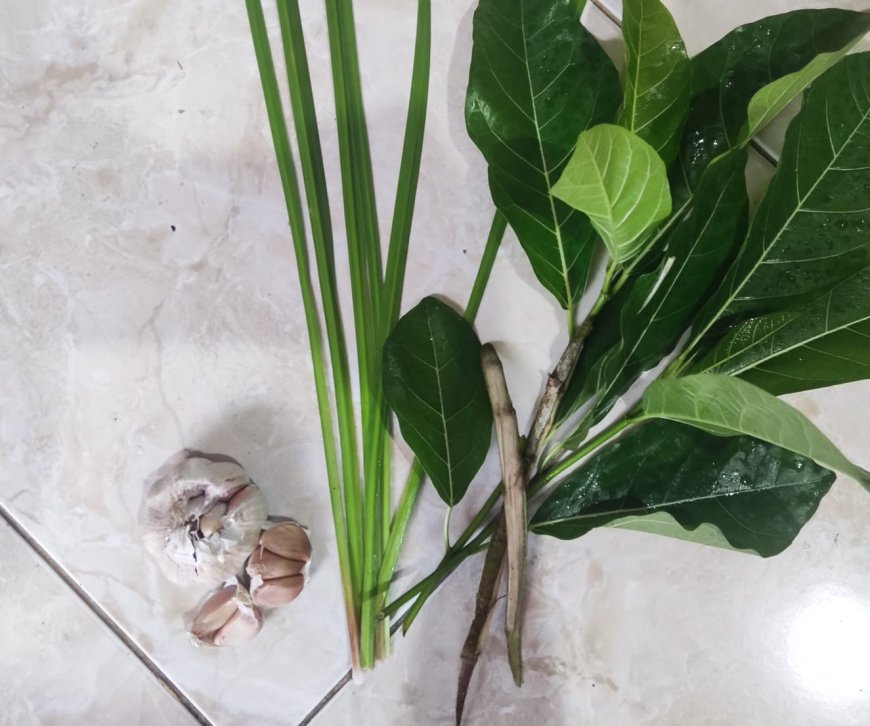
Ingredients for the Tiwang Nanipi (Photo Source : Private Collection)
When we first see the Jeringau or Jangu plant, we might wonder how to process and utilize this plant. One way to process and utilize it is by making one of the traditional herbal medicines mentioned in the "lontar usadha tiwang," namely "tiwang nanipi." Tiwang nanipi is a traditional remedy for treating tiwang disease with symptoms of abdominal pain and stabbing pain. The ingredients needed to make this remedy are 2 leaves of jangu, each about 15 cm long, 2 cloves of garlic, and a piece of awar-awar stem, approximately 5 cm long. Here are the steps for making and using the tiwang nanipi herbal remedy:
- Wash all the ingredients thoroughly with water.
- Chop all the ingredients with a knife.
- Prepare a mortar and pestle.
- Grind all the chopped ingredients in the mortar until smooth.
- The tiwang nanipi herbal remedy is ready to use.
- Apply the finely ground remedy around the painful area in the abdomen.
Additionally, Jangu or Jeringau can also be processed by making its decoction. Jeringau decoction can be consumed and inhaled to treat colds and nasal congestion. Moreover, the decoction can be mixed with bathwater, serving as an external (skin) remedy and a soothing agent.

Tiwang Nanipi (Photo Source : Private Collection)
The above information covers the benefits of Jeringau or Jangu, including its role in Balinese Traditional Herbal Medicine for Tiwang or Usadha Tiwang, its cultural significance in Bali, its scientific benefits, cultivation methods, and how to process and utilize this aquatic plant.




















